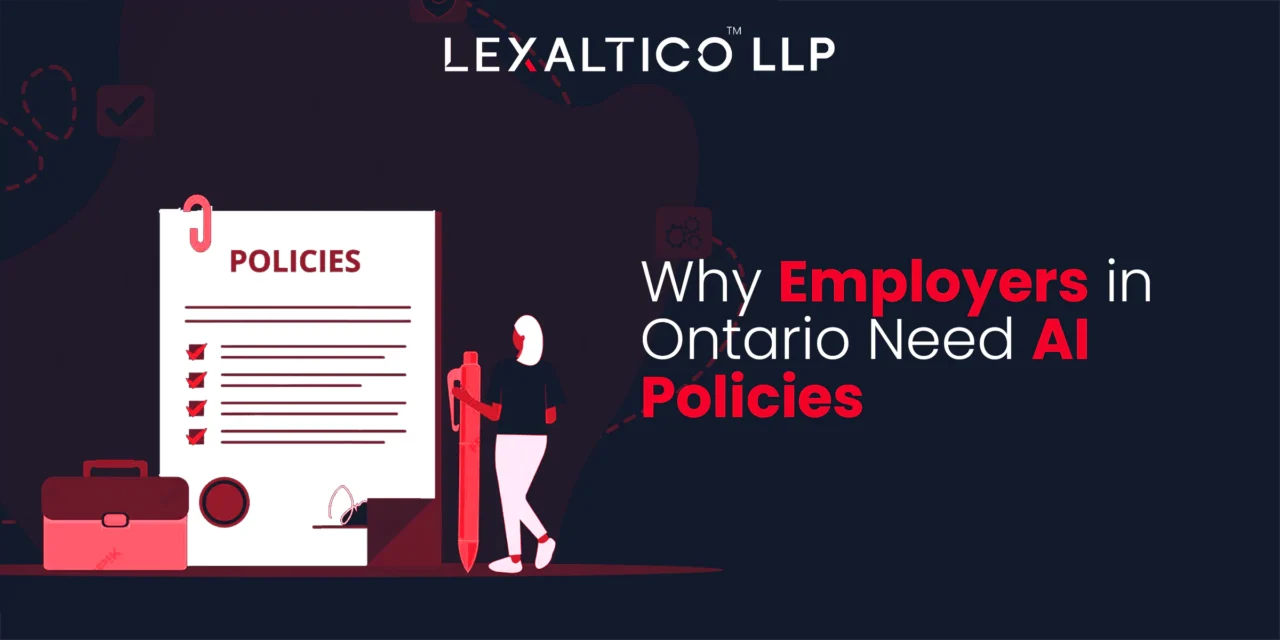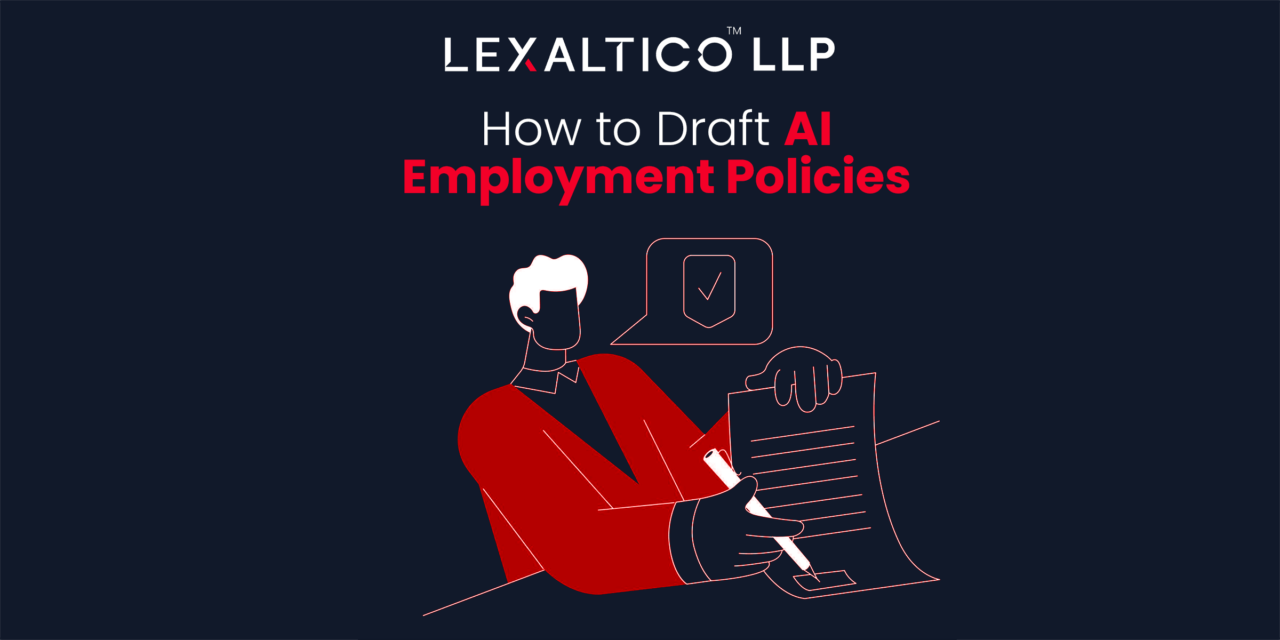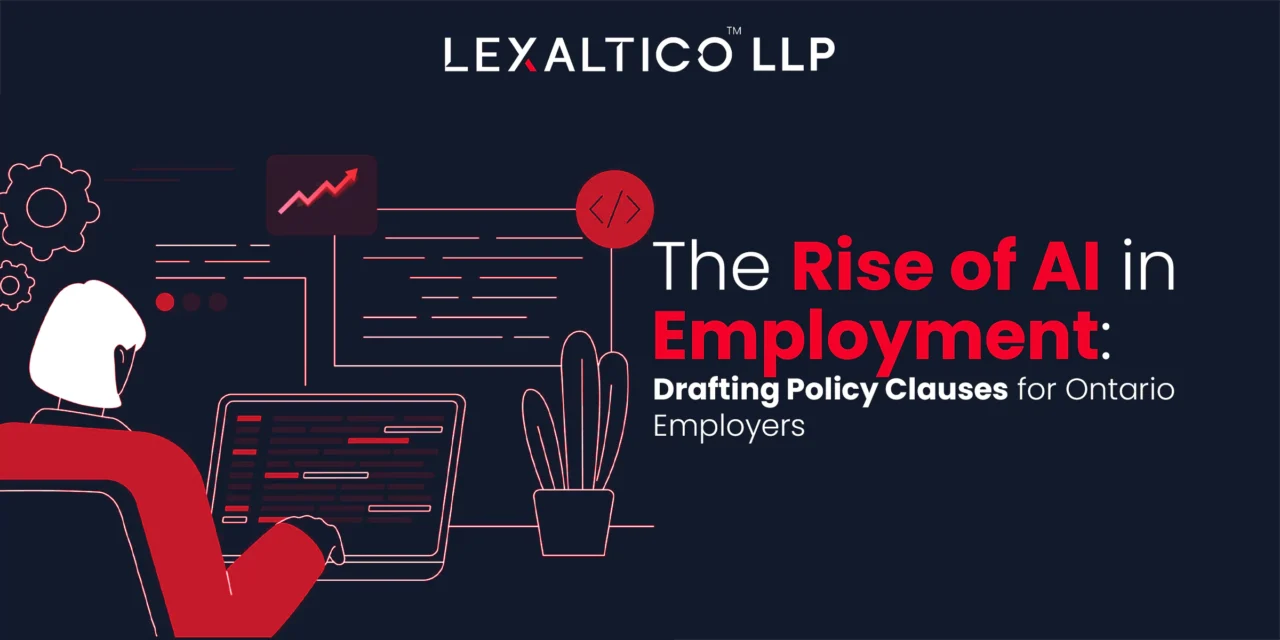Artificial Intelligence (AI) is changing how people work in Ontario and, in fact, in the whole world. Employers are starting to use AI for hiring, tracking performance, and workplace monitoring. But with new ESA disclosure rules and existing obligations under human rights and monitoring laws, Ontario employers are expected to build clear AI policies into their workplace practices.
Why employers in Ontario need AI policies

AI tools can read resumes, rank candidates, and even track worker activity. This may seem helpful, but it also comes with risks. AI can be unfair, it can collect too much personal data, and it can make decisions without human checking.
Because of these risks, Ontario has passed new laws to protect workers and to make sure employers use AI in a fair and open way.
The key laws in Ontario
Here are the main laws every Ontario employer needs to know:
- Employment Standards Act (ESA) – Job Posting AI Disclosure (Bill 149, 2024):
Starting January 1, 2026, employers with 25 or more workers must say in any public job posting if AI is being used to screen, rank, or select candidates. (Source: ESA Part III.1, Working for Workers Four Act, 2024). - ESA: Electronic Monitoring Policy (since 2022):
Employers with 25 or more workers must have a written policy if they monitor staff electronically. This includes AI systems that track productivity, keystrokes, or online activity. - Ontario Human Rights Code:
Employers must make sure AI does not discriminate against people because of race, gender, disability, age, or other protected grounds. In 2024, the Ontario Human Rights Commission (OHRC) released guidance and an AI impact assessment tool to help employers test workplace AI for fairness. - Privacy rules (PIPEDA):
Canada’s privacy law, PIPEDA, covers employee data only for federally regulated companies (like banks and airlines). For most Ontario businesses, it is not required by law. But it is best practice to follow PIPEDA rules, like collecting only the data you need, keeping it safe, and deleting it when no longer required.
Quick overview for employers
| Law / Rule | What it Means | Who it Applies To | When |
|---|---|---|---|
| ESA – Job Posting AI Disclosure (Bill 149) | Must say in job ads if AI is used in hiring | Employers with 25+ employees | Jan 1, 2026 |
| ESA – Electronic Monitoring Policy | Written policy on monitoring (including AI) | Employers with 25+ employees | In force now |
| Ontario Human Rights Code | No discrimination in hiring or work | All employers | Always |
| PIPEDA (privacy law) | Federal privacy law; best practice for all | Federally regulated employers (mandatory) | Always |
How to Draft AI Employment Policies

When writing an AI in employment policy in Ontario, keep the language simple, clear, and practical. Here are key parts to include:
- Transparency (being open):
Tell employees and job applicants when AI is used. Add a statement in job postings if AI helps make decisions.
Example: “This hiring process uses AI tools to review applications. All decisions include human review.” - Human Review:
AI should not make final decisions about hiring, firing, or pay. A human manager must check the result. - Bias checks:
Employers should test AI regularly to make sure it is not unfair to any group. Use the OHRC Human Rights AI Impact Assessment tool. - Employee rights:
Workers must be able to ask for a human review if they feel AI made a wrong decision. - Privacy:
Do not collect more data than needed. Protect sensitive information (like health data). Do not put private info into public AI tools. - Monitoring policy:
If AI tools are used to watch workers (for example, tracking activity on computers), this must be included in the Electronic Monitoring Policy.
Why this matters for employers
Using AI at work can be exciting, but it can also be risky. Employers in Ontario need to understand why AI policies are not just “nice to have,” but required by law and best practice. Here’s why it matters:
1. Legal compliance (following the law)
Ontario has already updated its Employment Standards Act (ESA). Starting January 1, 2026, employers with 25 or more workers must tell job seekers in any public job posting if AI is used to screen, rank, or select candidates. If an employer ignores this rule, they could face penalties or fines.
Also, since 2022, employers with 25 or more staff must have an Electronic Monitoring Policy if they watch employees through computers, phones, or AI tools. Without this policy, an employer is breaking the law.
2. Human rights and fairness
The Ontario Human Rights Code says that all people must be treated fairly at work. If an AI system unfairly treats someone because of their race, gender, age, disability, or other protected ground, the employer (not the AI tool) will be responsible.
For example, If an AI hiring tool rejects more women than men for a job, this could be seen as discrimination. This can lead to complaints, lawsuits, or damages.
3. Protecting privacy
Even though Ontario does not yet have a general private-sector privacy law for employee data, one has been proposed. Currently, only federally regulated employers must comply with PIPEDA.
If data is leaked, misused, or stored for too long, it can harm employees and damage trust. Employers may also face lawsuits for invasion of privacy.
4. Building trust with employees
Workers want to know when and how AI is used at work. If AI decisions are secret or unclear, employees may feel spied on or judged unfairly. This can lower morale and productivity.
On the other hand, if employers are open and explain AI use clearly, employees are more likely to trust the system. Trust leads to better teamwork and less conflict.
5. Protecting reputation
If a company is seen as using AI unfairly, it can hurt its reputation with workers, customers, and the public. News of biased hiring or unfair surveillance spreads quickly and can scare away top talent.
Conclusion
AI in the workplace is here to stay. By drafting AI use policies for employment now, Ontario employers can stay ahead of the law, avoid AI bias legal risks, and make hiring and monitoring fairer.
From AI hiring disclosure in Ontario job postings to AI and employee privacy in Ontario, the message is clear: employers must be transparent, fair, and safe when using AI at work.
Quick FAQs
Even before 2026, Ontario employers with 25 or more staff must have an Electronic Monitoring Policy, which can include AI tools. Starting early helps employers stay compliant and build trust.
It should explain when AI is used, how results are checked by humans, and how privacy is protected. It must also promise fairness, bias checks, and allow workers to ask for human review.
From January 1, 2026, employers with 25 or more workers must say in job postings if AI is used to screen or rank candidates. This is required under the Employment Standards Act (ESA).
Employers are always responsible for discrimination under the Ontario Human Rights Code, even if an AI tool caused it. They must test and monitor AI to prevent unfair results.
The proposed Artificial Intelligence and Data Act (AIDA), if passed, will regulate ‘high-impact’ AI systems, including some used in employment. Employers should start preparing governance policies now.
It’s not legally required to put AI clauses in employment contracts. Many employers instead address AI use in workplace policies or handbooks, which can be updated more easily.
Disclaimer: The information provided in this blog is for general informational purposes only. It is not legal advice and should not be relied on as such.



